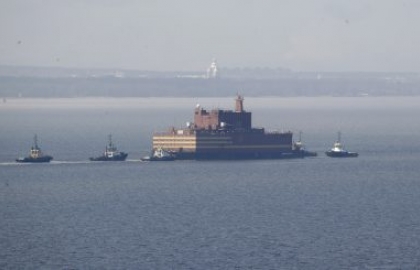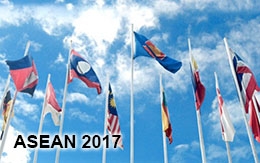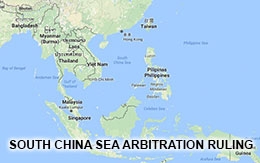China's planned floating nuclear power facilities in South China Sea: Technical and Political Challenges
The operation of the fleet of Chinese floating nuclear power plants in the South China Sea carries with it numerous safety and security risks that may have widespread consequences to not only China but also to Southeast Asia and beyond.

Whereas most of the nuclear power plants (NPPs) that have been built since the 1950s are land-based, in the maritime environment nuclear energy has been mainly used for propulsion purpose in nuclear-powered submarines, aircraft carriers, or icebreakers. The first floating electricity-generating reactor was built by the United States (U.S.) in the late 1960s using a MH-1A reactor of 45 MW thermal (MWt) and 10 MW electric (MWe) capacity, but noticeable interest in floating NPPs only surfaced in the 2000s when the Russian government announced the plan to construct its first floating NPP – the Akademik Lomonosov using two 150-MWt (38.5 MWe) KLT-40S pressurized reactors at an estimated cost of $170 million. Due to financial and technical issues, the Akademik Lomonosov was only delivered in 2018 – 8 years behind schedule at a cost about $700 million, or three time the original price tag.
Besides Russia, China has been the most promising candidate to have an operational floating NPP since the country started the construction of its first plant in 2016, which would be followed by up to 20 floating NPPs to be operated in the South China Sea once the demonstration unit is completed and deployed for trials in the Bohai Sea by 2020. However, different from Russia’s deployment of the Akademik Lomonosov to its undisputed waters in the Far East, the islands where the floating NPPs of China will likely be tethered have also been claimed by other states in the region like Vietnam or the Philippines. Accordingly, this article presents an in-depth analysis of the technical and legal issues regarding this ambitious plan by China.
China’s floating nuclear program
Despite initially considering to import floating NPP technology from Russia, in 2016 China announced its first Chinese floating nuclear project using a 200 MWt (60 MWe) ACPR50S reactor designed indigenously by the China General Nuclear Power (CGN), which was followed by a joint-venture led by the main competitor of CGN in the domestic nuclear market – the China National Nuclear Corp. (CNNC) in 2017 based on its own 310 MWt (100 MWe) ACP100S model. Aside from CGN and CNNC, other types of floating NPPs based on fast reactors have also been under research and development in China.
In general, land-based NPPs have several inherent limitations including extensive land requirement, sophisticated infrastructure for connection to the grid, and continuous and high demand for cooling water. Therefore, floating NPPs have long been considered the alternative technological solution for electricity, heating, or water desalination in remote coastal towns and small islands, as they have been designed mostly based on reactors of less than 300 MWe and to be transportable with the use of barge or ship.[1] For example, a floating NPP using an ACPR50 reactor can provide enough electricity for a community of about 100,000 people, or the daily water consumption for at least 60,000 people.
Given such advantages, it came as no surprise when Chinese officials announced that floating NPPs are to be built and deployed to the South China Sea in order to support China’s offshore oil and gas exploration, as well as to sustain the Chinese civilian presence in the Paracel and Spartly Islands in the South China Sea. However, the extreme land scarcity of the China-controlled islands, despite its land reclamation efforts, makes the civilian settlement expansion very unlikely, and thus rends this ambitious plan of up to 20 floating NPPs unjustifiable if only for civil facilities. Instead, by supplying Chinese infrastructures over the South China Sea with electricity and fresh water, these floating NPPs will help solidify China’s military foothold in this contested area, and raise the political and economic cost of any attack made by state or non-state actors against these China-controlled features. The military dimension of China’s intention to deploy floating NPPs to the South China Sea can be observed through the fact that at least one floating NPP project currently under development in China has been partially funded by the People’s Liberation Army. In addition, operational experiences from the deployment of floating NPPs in the South China Sea will be valuable for China’s plan to develop nuclear-powered aircraft carriers.
Technical challenges of floating NPPs in South China Sea
Due to the smaller size of the reactor and its being surrounded by abundance of cooling water during operation, floating NPPs have been considered safer than full-size, land-based NPPs. For example, the risks of earthquake and tsunami, which are the major concerns to the safety of land-based NPPs and were the main cause of the Fukushima nuclear accident, are essentially eliminated in case of floating NPPs deployed to deep waters.[2] However, multiple safety security issues remain related to China’s future operation of floating NPPs in the South China Sea, with which any incident occurs, whether it is a radioactive spill to the sea, or a containment damage caused by tropical cyclones or accidental collision with passing-by ships, will have serious economic and psychological impacts to regional states like Vietnam, the Philippines, or Singapore. Although countries in Northeast Asia like Japan and South Korea might not be directly affected by environmental consequences of such accidents, they will still suffer economically as both countries heavily depend on the oil and gas supply via shipping routes over this contested maritime area.
In terms of safety, floating NPPs are fraught with risks as they are often designed to store spent fuels and radioactive wastes on board for years. Radioactive sources might be leaked to the environment, causing serious hazards for human and the maritime ecological system if the vessel carrying this plant is rammed by a ship at high speed, or its hull is destroyed upon collisions with rocky surface during difficult weathers, or it is scuttled in shallow or deep waters.[3] Both the risks of ship collision, and of adverse weather conditions are typical operational concerns in the waters of the South China Sea, as a third of global shipping goes through this region, whereas the intensity of typhoons striking here has increased for more than 10% since the late 1970s, with higher rate of category-4 and category-5 (strongest wind-scale) tropical cyclones.[4] Moreover, because almost all radioactive release in case of floating NPP accidents will result in maritime contamination instead of partly land, partly maritime contamination like the case with land-based NPPs, accidents like core-melt scenario with maritime NPPs would become more damaging due to the quicker dispersion of radioactivity in maritime environment.[5]
In terms of security, as a floating NPP is operated on the ocean surface while being anchored near a small island, it cannot benefit from any natural defense barrier for its security. Thus, such a plant is vulnerable from attacks from both the surface (by fast boats), or underwater (by submarines, suicide divers), the latter of which are especially difficult to defend in comparison with other land-based NPPs. Perpetrators of such assaults could be pirates, terrorist groups, or other non-state actors with the goals of either damaging the reactor vessels to release radioactive materials to the environment, or hijacking the floating plant in order to steal radioactive materials for dirty bombs or other proliferation purposes.[6] To protect the plant from such attempts, experience can be drawn from the operation of nuclear-powered warships like aircraft carriers. However, given the military nature of these ships, the strategy and tactics to protect them from those security threats would not be applicable for floating NPPs, which are often civil facilities and do not enjoy the same level of protection like their armed counterparts.
Political and diplomatic tensions
In general, despite some concerns over possible transboundary consequences in cases of accidents, the deployment of the Akademik Lomonosov has been mostly without legal controversies as it was built, transported, and anchored within Russia’s territory. But there is a world of difference in the case of China’s deployment of floating NPP to the South China Sea. As is well known, several South East Asian countries are also claimants in part, or in whole, of the offshore features in the South China Sea, China's deployment of floating NPP would surely spark ire from its Southeast Asian neighbors and create diplomatic row over the issue. Other claimants may argue that the operation of China’s floating NPPs in the vicinity of these features is a clear violation of their sovereignty. In addition, they would argue that the operation of any floating NPP in their territorial waters needs the permission and supervision of their competent authorities. For example, according the 2008 Law on Atomic Energy of Vietnam, “transportation of radioactive materials transiting the Vietnamese territory, operation of seagoing ships and other vehicles that are nuclear-powered in the Vietnamese territory must be permitted by the Prime Minister and supervised by competent state management agencies”. [7] Therefore, if a floating NPP is defined by the Vietnam authority as a “nuclear-powered vessel”, its operators will be required to apply to the Prime Minister of Vietnam for a special permission of operation and to receive Vietnamese safety inspectors on board. This was the case of the first visit to Vietnam of the nuclear-powered aircraft carrier USS Carl Vinson in March 2018, when Vietnamese safety regulators were invited to visit the vessel for radiation monitoring while it was anchored off the coastal city of Danang. Although similar clause is not found in the 1968 Atomic Energy Regulatory and Liability Act of the Philippines, the Filipino government can still ask for its right to supervise the operation of China’s floating NPPs on the basis that they are operated in the country’s territorial waters and thus have to obey the Philippines’ laws related to vessels and shipping. As a claimant to the islands in the South China Sea, China would likely reject such demands from either Vietnam or the Philippines. If it is the case, it will create tensions, as other claimants will be likely to consider counter-measures to such deployment.
Besides the dispute over operating permission, China’s deployment of floating NPPs to the South China Sea will also create regional concerns over safety oversight and civil liability in case of nuclear accidents. Firstly, to ensure that a country can maintain the highest level of safety for its nuclear power program, an international system of legally-binding instruments has been developed including the Convention on Nuclear Safety, the Joint Convention on the Safety of Spent Fuel Management and on the Safety of Radioactive Waste Management (the Joint Convention), the Convention on Early Notification of a Nuclear Accident, and the Convention on Assistance in the Case of a Nuclear Accident or Radiological Emergency. The last two conventions were created after the Chernobyl nuclear accident (1986) in order to improve the international coordination and cooperation in case of nuclear incidents with possible transboundary consequences. Once a country ratifies the Convention on Nuclear Safety, it is required to participate in the review process of the Convention by submitting a national report to the triennial review meeting organized by the International Atomic Energy Agency (IAEA). Having participated in this Convention since 1996, China has regularly submitted to the review meetings its national reports on nuclear safety, which are made public by the IAEA for third parties. Southeast Asian countries are therefore able to verify whether or not China has implemented necessary safety measures for its civil nuclear facilities. However, such peer review will not be possible regarding the future floating NPP fleet of China, as the Convention on Nuclear Safety only covers land-based NPPs. Although the Convention on Early Notification of a Nuclear Accident, which includes all types of nuclear reactors and that has been ratified by China and all ASEAN countries, provides that states can request China to inform them should any accident occurs with its floating NPPs, it will be obviously too late for regional states to implement meaningful emergency response or mitigation plan in such case.
Secondly, regarding the financial compensation mechanism in cases when other countries are affected by nuclear accident, as they will be deployed and operated in the sea, Chinese floating NPPs will not be covered by either the Vienna Convention or the Paris Convention for civil liability, both of which only focus on land-based nuclear installations. The only international convention with such scope - the Brussels Convention on the Liability of Operators of Nuclear Ships (1962) has never been put into force.[8] Even if floating NPPs fall under the scope of either the Vienna or Paris Conventions, the civil liability issue with Chinese floating nuclear plants over the South China Sea would not be resolved, as China has neither participated in any international convention on civil liability in cases of nuclear accidents, nor has a coherent domestic legislation for such issue, especially in case of transboundary nuclear accidents.[9]
Conclusions
While many have viewed that the deployment of floating NPPs to the South China Sea could further complicate the security situation in this contested maritime area, China has largely doubled down on this ambitious project with the goal to test the first prototype of a made-in-China floating reactor in the Bohai Sea “well before 2020”. Once this demonstration step is completed, the construction and operation of the Chinese NPP fleet in the South China Sea will likely be accelerated and create numerous safety and security risks, which are elaborated in this paper. Given the transboundary consequences of any incident with these floating NPPs, which will affect not only regional nations like China, Vietnam, the Philippines, but also countries relying on the energy supply routes through the South China Sea like Japan and South Korea, it is necessary for these potential recipients of fallout from such incident to consider several policy countermeasures.
Firstly, the general development of the Chinese floating NPP program should be addressed through diplomatic and legal channels. For example, regional states, in cooperation with relevant international organizations like the IAEA or the ASEAN Network of Regulatory Bodies on Atomic Energy, may call for a multinational program to study the risks of operating NPPs in the South China Sea with the participation of any country that will be affected by such operation in order to provide China with a more comprehensive risk assessment of their program. In addition, the legal aspects of China’s deployment of floating NPPs to the South China Sea, including the legitimacy of such deployment, and whether such facilities should be considered artificial islands or maritime vessels, also need to be addressed so that regional states can form a coherent and reasonable voice against the Chinese floating NPP program in international venues.
Secondly, mechanisms to minimize the safety and security risks of the Chinese floating NPPs should be developed, including informal communication channels with China to exchange safety information of such facilities while being operated, [10] modification to the review process of the Convention on Nuclear Safety and Joint Convention on the Safety of Spent Fuel Management in order to take into account the new category of floating NPPs operated in contested waters, and a regional network for radiation monitoring and early warning of nuclear safety and security risks in adverse weathers and other difficult operating conditions. Finally, the civil liability of China in cases of transboundary consequences from nuclear accidents with its NPP fleet should be considered and negotiated by involving parties so that legal and financial provisions in such situations are in place well before the deployment of the floating NPPs to the South China Sea.
To conclude, it is necessary to emphasize that the operation of the fleet of Chinese floating NPPs in the South China Sea carries with it numerous safety and security risks that may have widespread consequences to not only China but also to Southeast Asia and beyond. Therefore, such deployment should be thoroughly evaluated by relevant states, while measures to minimize those risks must be developed as early as possible in order to not make the situation in the South China Sea more complicated that it already is.
Viet Phuong Nguyen is a postdoctoral fellow with the International Security Program and Project on Managing the Atom of the Belfer Center for Science and International Affairs, Harvard Kennedy School, where he also was a pre-doctoral fellow from 2016 to 2017.
Click here for pdf file.
[1] J.W. Kindt, "Floating nuclear power plants: US and international regulations," Marine Policy 7:2 90-100, 1983.
[2] J. Buongiorno, J. Jurewicz, M. Golay, and N. Todreas, "The offshore floating nuclear plant concept," Nuclear Technology 194:1 1-14, 2016.
[3] V.F. Demin, and V.P. Kuznetsov, "Issues of insurance of civil liability for nuclear damage from nuclear low power plants," Proceedings of the ASME 2014 Small Modular Reactors Symposium SMR2014, April 15-17, 2014, Washington, DC, USA.
[4] W. Mei, and S.P. Xie, "Intensification of landfalling typhoons over the northwest Pacific since the late 1970s," Nature Geoscience 9 753-747, 2016.
[5] Kindt, "Floating nuclear power plants."
[6] M.J. Ford, A. Abdulla, and M.G. Morgan, "Evaluating the cost, safety, and proliferation risks of small floating nuclear reactors," Risk Analysis 37:11, 2017.
[7] Law on Atomic Energy (No. 18/2008/QH12), Ministry of Justice of Vietnam.
[8] J. Handrlica, "The Vienna Convention on Civil Liability for Nuclear Damage and Nuclear Installations: Application Problems Revisited," Czech Yearbook of Public and Private International Law 6, 149-160, 2015.
[9] L. Jing, and M. Faure, "Compensating nuclear damage in China," Global Nuclear Energy Law and Regulatory Symposium 11:4 781-815, 2012.
[10] Such communication channels can be built based on the experience between Vietnam and China during the development of mechanism to exchange safety information related to the construction and operation of Chinese NPPs located near the border between the two countries. Hoang Dan, "3 nhà máy điện hạt nhân Trung Quốc nằm gần biên giới Việt Nam đi vào hoạt động" (in Vietnamese), Soha.vn, April 6, 2017.






![[9th OCEAN DIALOGUE] | ONLINE PARTICIPATION IS NOW OPEN](/temp/-uploaded-2022_ảnh_Viber_2022-09-20_10-34-27_cr_96x78.jpg)



